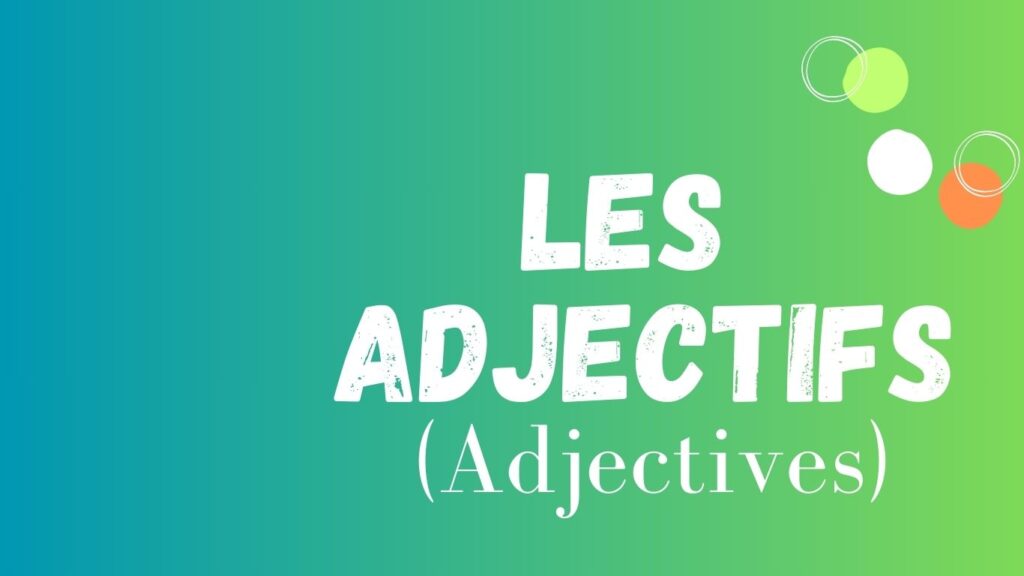Adjectives are words used to describe or modify nouns by providing additional information to the noun like its quality, color, shape, characteristics, etc.
Just like articles, French adjectives need to be modified according to the gender and number of the noun.

E.g.
| GENDER | MASCULINE | FEMININE |
| SINGULAR | Manav est grand. | Priya est grande. |
| PLURAL | Manav et Manuel sont grands. | Priya et Ashna sont grandes. |
Refer to the above table, you will notice the change occurs and these are common changes that most of the adjectives follow.
- In the Feminine form- there is an added “e” to the masculine form.
- If the masculine form is already ending with ‘e’ then the feminine form remains the same. Eg. rouge, facile, belge, jeune,etc.
- In the Plural, add “s” to the masculine form then it forms the masculine plural.
- Add “es” to the masculine form to make it feminine plural.
Therefore, here are some of the adjectives that have the same pattern to modify according to the noun.
| MASCULINE SINGULAR | FEMININE SINGULAR | MASCULINE PLURAL | FEMININE PLURAL |
| grand (big/tall) | grande | grands | grandes |
| blond (hair colour) | blonde | blonds | blondes |
| brun (brown) | brune | bruns | brunes |
| petit (small/short) | petite | petits | petites |
| sympathique (kind) | sympathique | sympathiques | sympathiques |
| intelligent (intelligent) | intelligente | intelligents | intelligentes |
| amusant (enjoy) | amusante | amusants | amusantes |
| joli (pretty/handsome) | jolie | jolis | jolies |
| laid (ugly) | laide | laids | laides |
| content (happy) | contente | contents | contentes |
| mécontent (unhappy) | mécontente | mécontents | mécontentes |
EXCEPTIONS
- When an adjective ends with an ”e” (e.g. Mince) then it does not change in gender.
- When an adjective ends with ”s” (e.g. Gros) then it does not change in the masculine plural form.
- Sometimes with some adjectives, we have to double the final consonant and then add ”e” to make it feminine. Then add an ”s” to make it feminine plural.
Here are few examples to help you understand how it works:
| MASCULINE SINGLUAR | FEMININE SINGULAR | MASCULINE PLURAL | FEMININE PLURAL |
| mince (thin) | mince | minces | minces |
| gros (fat) | grosse | gros | grosses |
| moyen (average) | moyenne | moyens | moyennes |
| bon (good) | bonne | bons | bonnes |
| mauvais (bad) | mauvaise | mauvais | mauvaises |
| beau (beatiful/handsome) | belle | beaux | belles |
EXCEPTIONS
- If the adjective is ending with ‘eau’ in the masculine form then change to ‘elle‘ to make it feminine form. Ex. beau— belle, nouveau— nouvelle, etc.
- And, the plural is made by adding ‘x‘ at the end of the masculine singular form. For ex. beau— beaux, nouveau— nouveaux.
- But the adjectives like beau, nouveau, vieux, etc. change to bel, nouvel, vieil when used before a noun begining with vowel and is masucline form also.
Position of Adjectives
Most of the adjectives are placed after the noun.
- Adjectives of colour. For ex. Le stylo bleu.
- Adjectives indicating forms and shapes. For ex. le nez rond.
- Adjectives which indicate nationality. For ex. le prof français.
Certain short descriptive adjectives are placed before the nouns. For ex. petit, gros, faux, vrai, mince, joli, gentil, jeune, grand, nouveau, beau.
Some more set of adjectives that are used before the nouns are: chaque, tout, autre, dernier, premier, quelques, plusieurs.
- For eg. une grosse fille et un joli garçon.
- prends un autre pain.
- Quelques de bonbons dans le sac.
Note: ‘des’ becomes ‘de’ when the adjectives are used before the noun in the plural form. For ex. Ce sont de belles filles. But if the adjective is placed after the noun there is no change in the article. For ex. Ce sont des livres rouges.
